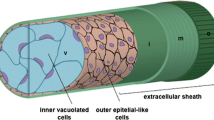Abstract.
Teneurins are a unique family of transmembrane proteins conserved from Caenorhabditis elegans and Drosophila melanogaster to vertebrates, in which four paralogs exist. In vertebrates, teneurin expression is most prominent in the developing brain. Based on their distinct, complementary expression patterns, we suggest a possible function in the establishment of proper connectivity in the brain. Functional studies show that teneurins can stimulate neurite outgrowth, but they might also play a role in axon guidance as well as in target recognition and synaptogenesis, possibly mediated by homophilic interactions. Though teneurins are transmembrane proteins, there is evidence that the intracellular domain has a nuclear function, since it can interact with nuclear proteins and influence transcription. Therefore, we speculate that teneurins might be processed by proteolytic cleavage (possibly regulated intramembrane proteolysis), which is triggered by homophilic interactions or, alternatively, by the binding of a still unknown ligand.
Similar content being viewed by others
Author information
Authors and Affiliations
Corresponding author
Additional information
Received 28 February 2007; received after revision 28 March 2007; accepted 17 April 2007
Rights and permissions
About this article
Cite this article
Kenzelmann, D., Chiquet-Ehrismann, R. & Tucker, R.P. Teneurins, a transmembrane protein family involved in cell communication during neuronal development. Cell. Mol. Life Sci. 64, 1452 (2007). https://doi.org/10.1007/s00018-007-7108-9
Published:
DOI: https://doi.org/10.1007/s00018-007-7108-9




